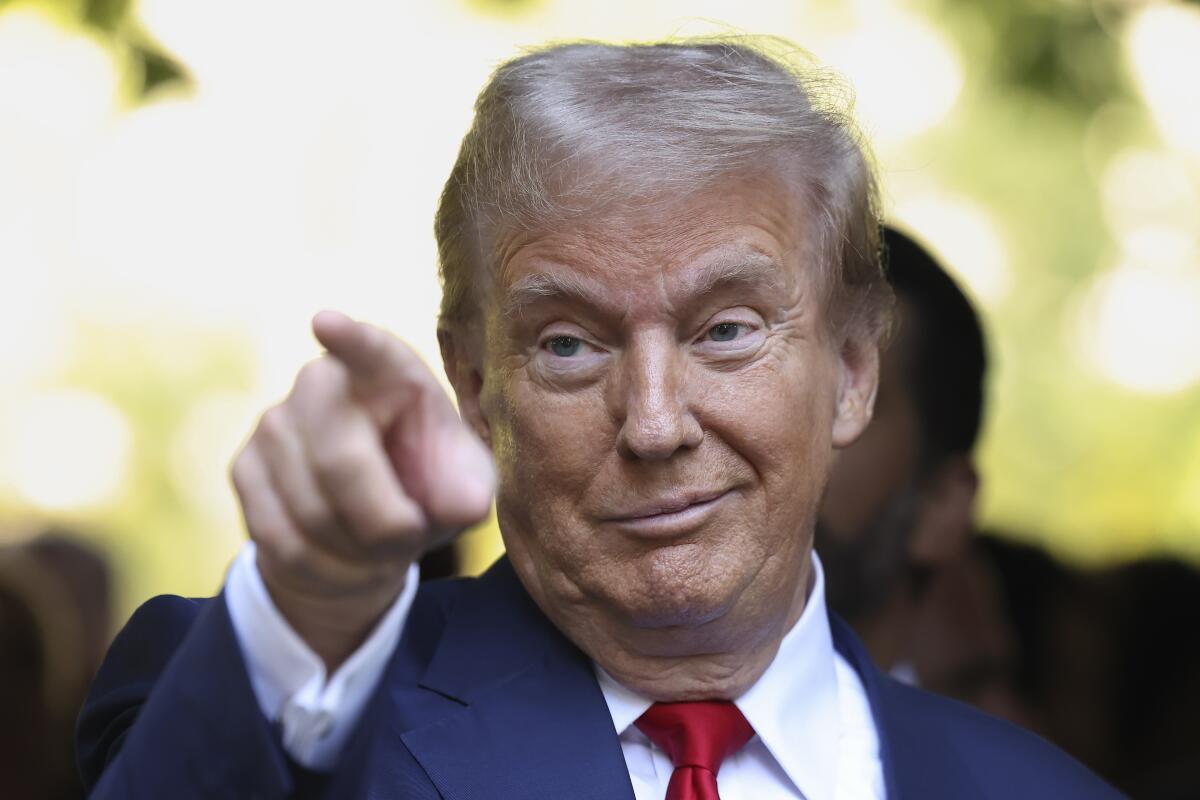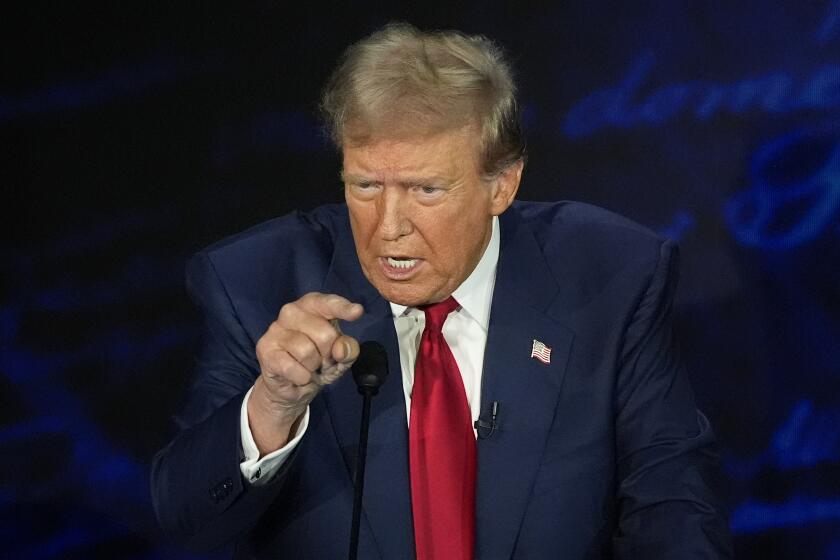Opinion: Think of Donald Trump as Robin Hood in reverse. Here’s why

- Share via
If Trump is elected president, he will have pulled off quite the con — Robin Hood in reverse. His economic policies call for transferring trillions in resources from the poor and middle class to the rich, only minimally dressed up in populism and grievance.
Trump consistently blames immigrants and foreigners for taking American jobs and hollowing out heartland factory towns. But his stance blaming “outsiders” for all that ails America, and at the same time proposing draconian trade and immigration policies, will harm more than help U.S. workers.
Trump’s 2024 tariff proposals — tariffs are taxes paid on imported goods — would take his first-term policies into disastrous Smoot-Hawley territory, and they would disproportionately burden low-income and middle-class Americans. People in those groups must spend all or most of their income to get by, whereas richer Americans can afford to save a share of theirs. Tariffs raise prices of imports and the domestic goods that compete with them, and those that spend most or all of their income are immediately affected.
Trump and Vance claim that tariffs are paid by foreign companies and that economists are divided on the topic. They’re wrong on both counts
Economic research has left no doubt that U.S. tariffs burden Americans rather than foreigners. They also tend to depress trade and production; any job creation benefits are generally more than offset by harms. For example, research indicates that Trump’s tariffs of 2018-19 cost households about $800 per year, and studies found job losses due to foreign retaliation but no discernible effect on employment in the newly protected sectors. In the case of steel tariffs, exceedingly modest job creation was dwarfed by job loss many times higher in U.S. industries that use steel as an input.
Similarly, the draconian immigration policies that Trump imagines — his promised “largest deportation operation in the history of our country” — would be deeply harmful to the economic prosperity of the United States, not to mention immoral, tearing apart families and lives. Rather than businesses simply turning to “Americans” to fill in for the deportees, research shows that many of those jobs (and businesses) disappear — 88,000 for every 1 million deportees.
It’s unsurprising that economic luminaries conclude that Trump’s trade and immigration proposals would create enormous “stagflationary” headwinds, risking simultaneous increases in recessionary and inflationary pressures. Why would he pursue such harmful, risky policies?
Year-over-year price increases reach a three-year low, clearing the way for the Federal Reserve to cut interest rates next week.
Blaming “others” for economic stresses is a smoke-and-mirrors distraction from the rest of his agenda, which is deeply unpopular with most Americans: cutting taxes for the well-off and corporations. Although Trump claims to want broad tax relief, when you do the math related to extending his first-term tax breaks, alongside his tariff proposals, most Americans would be worse off.
Except those at the top.
Beyond extending his first-term tax cuts, Trump has vowed to cut the corporate tax rate again, to 15%, disproportionately benefiting shareholders or capital owners. (Taxes on labor income, payroll taxes and tariffs fall more heavily on workers.)
Likewise, his speculative plan to exempt Social Security from taxation, while seemingly generous to all retirees, would mostly benefit well-off retirees while deeply increasing fiscal pressures on the program, risking cuts to benefits in the years ahead.
What about Trump’s proposal to exempt tips from taxation, which the Harris campaign has mimicked? Although it could benefit poorer workers, without serious guardrails it could also open large new channels of tax avoidance. Both campaigns are probably more concerned with winning votes among service workers in the swing state of Nevada than with the principles of good tax policy.
Even if the topic was his 2020 election loss or the Jan. 6 insurrection, Trump brought up immigration in his debate against Harris.
A final danger with the Trump fiscal agenda is that it will blow deeper holes in budget deficits and debt, already problematically high. Trump’s tax agenda could easily cost $5 trillion or $6 trillion over the coming decade, and despite his wishful thinking about replacing income taxes with tariffs, the math, again, doesn’t add up. And Trump has never shown much interest in reining in spending; his administration added far more to the national debt than Biden’s has.
A potential Harris administration should not learn the wrong lessons from Trump. It’s true that President Biden left many of Trump’s China tariffs in place, even as they failed to achieve changes in Chinese trade practices. And the Biden-Harris administration levied new tariffs on $18 billion in Chinese products. Still, these new tariffs target far less than 1% percent of the trade that the proposed Trump tariffs would tax, and they focus on protecting key strategic domestic industries. The Biden-Harris administration explicitly rejected the kind of broad tariffs that Trump suggests. Harris correctly calls them a “Trump sales tax”.
America’s “kitchen table” economic issues can’t be solved by blaming foreigners and immigrants. Scapegoats are an easy answer for complex problems that instead require strengthening U.S. fundamentals, thoughtful engagement with our trading partners and building a fairer tax system. Make no mistake, Trump’s proposals are snake oil, pure and simple.
Kimberly A. Clausing is the Eric M. Zolt Professor of Tax Law and Policy at the UCLA School of Law. She was deputy assistant secretaryfor tax analysis at the U.S. Treasury during 2021-22.
More to Read
A cure for the common opinion
Get thought-provoking perspectives with our weekly newsletter.
You may occasionally receive promotional content from the Los Angeles Times.












